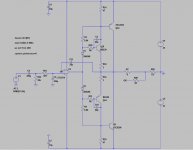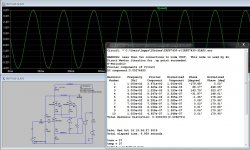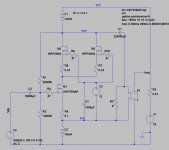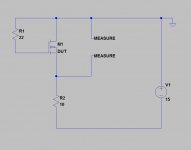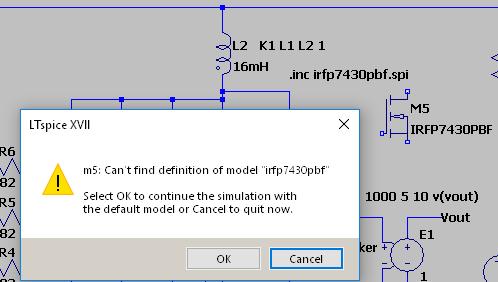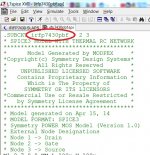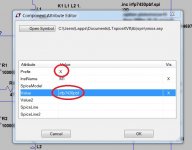The way they are connected, there is no cancellation (fortunately, as otherwise the output signal would be shorted to the supplies), which means that the core will have to bear all of the DC magnetization.It is rather clever in that the coupled inductors cancel out magnetic flux from DC current (perfectly in theory, more or less imperfectly in practice).
The advantage of coupled coils is that the values are multiplied by 4 instead of 2, but winding the same number of turns in a single coil has the same result, except it is a bit more perfect.
Using air-cored transformer or chokes for that business is by no means impossible (as I demonstrated somewhere in tube forum, but the idea was flamed by iron-lovers), but it requires a substantial number of kilograms of copper (tens, ideally) to work really well.
I have given it a thought, but I lack the knowledge to take it to the next step.
Do you have any simple circuitry in mind?
Yes, here a simple circuit I made only for you
It is running in AB/C Bias and a simulated performance of ~ 0.002% THD. Easy to change to pure AB and much better THD, if required.
Attachments
Thanks for your efforts, moschfet.
Sadly it does seem to still have NFB.
As such, I think my class A Trimodal does it better.
Sadly it does seem to still have NFB.
As such, I think my class A Trimodal does it better.
The AMTs also have an outstanding resolution, but they are at the same time merciless in revealing any amplifier's misconduct.
My current 25 W class A amplifier is no exception.
I've been suggested to give up on complex amplifiers and instead try something simpler and with no feedback at all.
which means that the core will have to bear all of the DC magnetization.
Using air-cored transformer or chokes for that business is by no means impossible
This is an air cored coil. 2 x 100 meters of 1,5 mm2 cable makes a nice 2 x 16 mH inductance, which is more then enough to get a -3 dB point driving a 6 ohm load of 1,5 Hz with feed forward error correction. I suspect the distortion increases in the bass due to the low inductance, but it is nothing I have heard while driving bass horns with a similar amp.
The advantage of coupled coils is that the values are multiplied by 4 instead of 2, but winding the same number of turns in a single coil has the same result, except it is a bit more perfect.
This is one of the benefits of this design. This fact partly explains the great but surprising performance from such a cheap and small bifilar coil.
Global negative feedback might do well in simulation, but it never sounds as good as feed forward error correction in my experience. There is usually a very hard to explain and hard to quantify "immediate effortless presence" with amps that does not rely on global negative voltage feedback for its low THD and high damping factor.
You can hear it when playing full range, fine. But second harmonic of 10kHz is 20kHz. Can you hear it?
http://www.firstwatt.com/pdf/art_dist_fdbk.pdf
A great article explaining why low levels measured THD with a simple sinewave into a dummy load is of very little importance for the sound of amplifiers.
If you want to use a higher voltage (32 Volts) from the power supply and lower distortion then you could experiment with cascode operation. This will lower distortion and lower the gate capacitance seen from the preamp.
http://www.firstwatt.com/pdf/art_cas_amp.pdf
This is what Nelson Pass has to say about cascode operation of gain devices.
I have never tried this so I can not recommend it based on my own experience. It would be quite interesting experiment though....
http://www.firstwatt.com/pdf/art_cas_amp.pdf
This is what Nelson Pass has to say about cascode operation of gain devices.
I have never tried this so I can not recommend it based on my own experience. It would be quite interesting experiment though....
Attachments
Yes!
http://www.firstwatt.com/pdf/art_matching.pdf
A simple way to get a close enough matching of devices.
This is the way I measure the Device Under Test. I monitor the current draw on my lab power supply and the Voltage over Drain to Source with a multimeter.
Remember to clamp the devices to a heat sink.
http://www.firstwatt.com/pdf/art_matching.pdf
A simple way to get a close enough matching of devices.
This is the way I measure the Device Under Test. I monitor the current draw on my lab power supply and the Voltage over Drain to Source with a multimeter.
Remember to clamp the devices to a heat sink.
Attachments
Last edited:
I would use something like one single IRFP7430 and three matched IRFP150 per channel as a starting point. I have not built a cascoded split load phase splitter amp so it is only a guess about what should work well.
I would encourage you to build a simple single device version first to test the general idea. I believe the simple non-cascoded amp would sound very good driving your impressive high resolution AMTs and hopefully better then your previous amps.
The cascoded version is meant as a potential future way forward if you want to experiment with some wild ideas. Casoding does change the sound character quite a bit. But there are some pitfalls to. Cascoding can be prone to HF-instabilities which can be hard to detect in steady state measurements.
I would encourage you to build a simple single device version first to test the general idea. I believe the simple non-cascoded amp would sound very good driving your impressive high resolution AMTs and hopefully better then your previous amps.
The cascoded version is meant as a potential future way forward if you want to experiment with some wild ideas. Casoding does change the sound character quite a bit. But there are some pitfalls to. Cascoding can be prone to HF-instabilities which can be hard to detect in steady state measurements.
Because voltage-induced nonlinearities take the form of "compressive"
intermodulation, it was not surprising to discover the sonic effects of
utilizing cascode operation throughout a power amplifying system
corresponded to an impression of a dynamic range capability considerably beyond what the rated power would suggest. This effect is
pronounced at high transient levels and imparts a sense of
effortlessness in the reproduction of demanding material.
http://www.firstwatt.com/pdf/art_zv8.pdf
http://www.firstwatt.com/pdf/art_zv9.pdf
If you want to go all out and invest the time and energy into a cascoded version then you should read Nelson Pass two articles about the Zen ZV8 and ZV9 and especially the part called "Installment 2 – Cascode Modulation" in the Zen ZV9 article.
Since the IRFP7430 and the IRFPS3810 (another option for M1) has a more pronounced "Triody" transfer curve then the Jfet used in ZV8 and ZV9, you could probably use cascode modulation to substantially lower distortion without using negative feedback. This is best done with a specific loudspeaker in mind, as the lowest amount of THD on the amplifier output will not always translate into the lowest possible amount of distortion from your loudspeaker. I would experiment with the cascode modulation while the amp was driving the intended loudspeaker and make incremental measurements and long time listening tests. This would at least be a 6 month endeavour for me, as it takes time to optimize the amp-speaker-preference interaction.
http://www.firstwatt.com/pdf/art_zv9.pdf
If you want to go all out and invest the time and energy into a cascoded version then you should read Nelson Pass two articles about the Zen ZV8 and ZV9 and especially the part called "Installment 2 – Cascode Modulation" in the Zen ZV9 article.
Since the IRFP7430 and the IRFPS3810 (another option for M1) has a more pronounced "Triody" transfer curve then the Jfet used in ZV8 and ZV9, you could probably use cascode modulation to substantially lower distortion without using negative feedback. This is best done with a specific loudspeaker in mind, as the lowest amount of THD on the amplifier output will not always translate into the lowest possible amount of distortion from your loudspeaker. I would experiment with the cascode modulation while the amp was driving the intended loudspeaker and make incremental measurements and long time listening tests. This would at least be a 6 month endeavour for me, as it takes time to optimize the amp-speaker-preference interaction.
I suspect you might well find the reason for this when looking at THD(f). It has been found that when distortion is non-negligible, a flat profile is preferred... so an amplifier that gives 0.03% at 1 and 10 kHz is probably preferable to one that goes from 0.01% at 1 kHz to 0.1% at 10 kHz.Global negative feedback might do well in simulation, but it never sounds as good as feed forward error correction in my experience. There is usually a very hard to explain and hard to quantify "immediate effortless presence" with amps that does not rely on global negative voltage feedback for its low THD and high damping factor.
The higher the frequency, the harder applying lots of feedback becomes, and the more is in the loop, the slower it has to be. This is why people are using higher-order compensation schemes, to get the most out of limited bandwidth.
Uhm, Mr. Pass seems to say nothing of the sort... even though he does explain why high-frequency THD does absolutely matter.http://www.firstwatt.com/pdf/art_dist_fdbk.pdf
A great article explaining why low levels measured THD with a simple sinewave into a dummy load is of very little importance for the sound of amplifiers.
He'd rather not have to apply obscene amounts of global negative feedback so as to avoid the hassles that go along with it, which I say is fair enough.
Bruno Putzeys has had something to say about similar topics:
https://www.hypex.nl/img/upload/doc/an_wp/WP_AES123BP_the_engineers_survival_guide.pdf
He is one of those engineers who like to apply lots of feedback "not because it is easy, but because it is hard" (to quote John F. Kennedy when introducing one of the greatest engineering challenges of the 20th century). But even he clearly concludes that improved open-loop linearity gives disproportionate benefits and as such is clearly desirable. Of course this generally comes at the cost of either higher power consumption or circuit complexity, but still, if you have that kind of headroom...
http://www.firstwatt.com/pdf/art_zv8.pdf
http://www.firstwatt.com/pdf/art_zv9.pdf
If you want to go all out and invest the time and energy into a cascoded version then you should read Nelson Pass two articles about the Zen ZV8 and ZV9 and especially the part called "Installment 2 – Cascode Modulation" in the Zen ZV9 article.
Since the IRFP7430 and the IRFPS3810 (another option for M1) has a more pronounced "Triody" transfer curve then the Jfet used in ZV8 and ZV9, you could probably use cascode modulation to substantially lower distortion without using negative feedback. This is best done with a specific loudspeaker in mind, as the lowest amount of THD on the amplifier output will not always translate into the lowest possible amount of distortion from your loudspeaker. I would experiment with the cascode modulation while the amp was driving the intended loudspeaker and make incremental measurements and long time listening tests. This would at least be a 6 month endeavour for me, as it takes time to optimize the amp-speaker-preference interaction.
Cascode Modulation looks really exiting!
I found the IRFPS3810 rather pricey and it also had long delivery time, so I'll go for IRFP7430.
Can IRFP054NPBF be a substitute for IRFP250N or is the Maximum Drain Source Voltage too low?
Yes it worked. Now I can simulate the cascode.
So the plan is to build three more of the single 054:ers and evaluate them:
Then I'll see if I can get four 054 in parallel to be stable (with 0.47 ohm source resistors):
Later on, it is the cascode's turn:
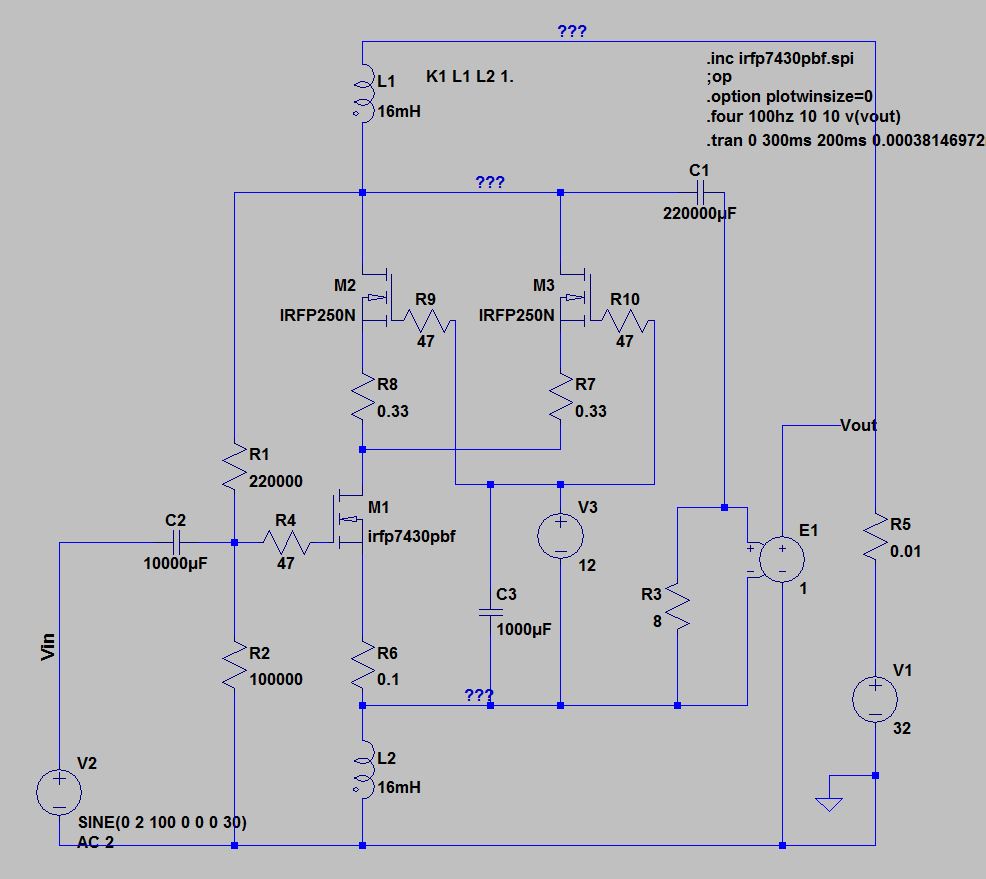
It'll be a quite busy but fun autumn/winter.
But now I have three more coils to wind...
So the plan is to build three more of the single 054:ers and evaluate them:
An externally hosted image should be here but it was not working when we last tested it.
Then I'll see if I can get four 054 in parallel to be stable (with 0.47 ohm source resistors):
An externally hosted image should be here but it was not working when we last tested it.
Later on, it is the cascode's turn:
It'll be a quite busy but fun autumn/winter.
But now I have three more coils to wind...
An externally hosted image should be here but it was not working when we last tested it.
But now I have three more coils to wind
Nice forearm burn! (if you don´t have a coil winding machine of some sort).
I am really looking forward to hearing your impression once all 4 channels are up and running. I believe your AMTs will reward you with a whole new level of detail, resolution and presence (something they already excel at).
Their remarkable ability to reproduce complex signals and sharp transients with ease really impressed me!
- Status
- This old topic is closed. If you want to reopen this topic, contact a moderator using the "Report Post" button.
- Home
- Amplifiers
- Solid State
- SLAPS for SLAM!
